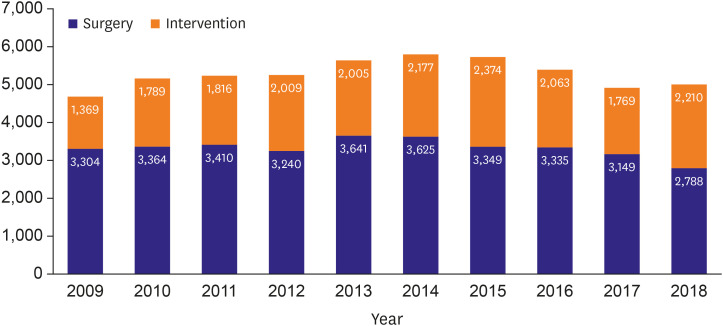Korean Circ J.
2020 Aug;50(8):691-694. 10.4070/kcj.2020.0216.
Global Burden of Congenital Heart Disease: Experience in Korea as a Potential Solution to the Problem
- Affiliations
-
- 1Division of Cardiology, Department of Pediatrics, Seoul St. Mary's Hospital, College of Medicine, The Catholic University of Korea, Seoul, Korea
- KMID: 2505122
- DOI: http://doi.org/10.4070/kcj.2020.0216
Figure
Cited by 1 articles
-
Congenital Heart Disease in Premature Infants Less than 1,500 grams: It Takes a Delicate Touch from Many Multidisciplinary Experts
Jin-Hee Oh
Korean Circ J. 2020;50(12):1124-1126. doi: 10.4070/kcj.2020.0426.
Reference
-
1. van der Linde D, Konings EE, Slager MA, et al. Birth prevalence of congenital heart disease worldwide: a systematic review and meta-analysis. J Am Coll Cardiol. 2011; 58:2241–2247. PMID: 22078432.2. Peyvandi S, Baer RJ, Chambers CD, et al. Environmental and socioeconomic factors influence the live-born incidence of congenital heart disease: a population-based study in California. J Am Heart Assoc. 2020; 9:e015255. PMID: 32306820.
Article3. Hoffman JI, Kaplan S. The incidence of congenital heart disease. J Am Coll Cardiol. 2002; 39:1890–1900. PMID: 12084585.
Article4. Institute for Health Metrics and Evaluation. Global Burden of Disease 2017 [Internet]. Seattle (WA): Institute for Health Metrics and Evaluation;2018. cited 2020 May 1. Available from: http://ghdx.healthdata.org/gbd-results-tool.5. Zheleva B, Atwood JB. The invisible child: childhood heart disease in global health. Lancet. 2017; 389:16–18. PMID: 27989557.
Article6. Hoffman JI. The global burden of congenital heart disease. Cardiovasc J Afr. 2013; 24:141–145. PMID: 24217047.7. Tchervenkov CI, Jacobs JP, Bernier PL, et al. The improvement of care for paediatric and congenital cardiac disease across the world: a challenge for the World Society for Pediatric and Congenital Heart Surgery. Cardiol Young. 2008; 18(Suppl 2):63–69.
Article8. Bernier PL, Stefanescu A, Samoukovic G, Tchervenkov CI, et al. The challenge of congenital heart disease worldwide: epidemiologic and demographic facts. Semin Thorac Cardiovasc Surg Pediatr Card Surg Annu. 2010; 13:26–34. PMID: 20307858.
Article9. Shin HJ, Park YH, Cho BK. Recent surgical outcomes of congenital heart disease according to Korea Heart Foundation data. Korean Circ J. 2020; 50:677–690.
Article10. The Korean Heart Foundation. The present status of cardiovascular surgery in Korea [Internet]. Seoul: The Korean Heart Foundation;2020. cited 2020 May 1. Available from: https://new.heart.or.kr.
- Full Text Links
- Actions
-
Cited
- CITED
-
- Close
- Share
- Similar articles
-
- Congenital Heart Disease After Childhood: Experience of Grown up Congenital Heart Clinic(GUCH Clinic)'
- Environmental changes surrounding congenital heart disease
- Travel-related Injury
- Aorto-Right Ventricular Tunnel: An Uncommon Problem with a Common Solution
- Clinical Experience of Cleft Lip and/or Palate Repair in Complex Congenital Heart Disease


